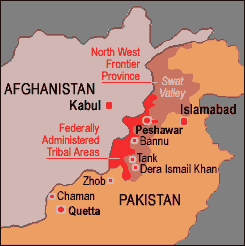Pewar
| Author:Laxman Burdak, IFS (R) |

Pewar or Peohar is a village in Pakistan, near to Parachinar Federally Administered Tribal Areas of Pakistan. Pewar has four seasons. Pewar is very famous for its fresh fruits, fresh vegetables and snowfall.
Location
Pewar is 16 km far from the capital city Parachinar of Kurram Agency, and the one of the village near to Parachinar Federally Administered Tribal Areas of Pakistan. Pewar is situated on a neck of Pakistani territory south of Peshawar, that juts into Paktia Province of Afghanistan. It is the closest point in Pakistan to Kabul and borders on the Tora Bora region of Afghanistan.
History
The name Pewar may derive from Pashto word Pawar which mean one by one people come to protect that area which is located too near the border to Afghanistan. The previous name, used for Pawar was Tutki, which is still used by some Afghan people. The inhabitants of Tutki were called Tutkiwal.
Parachinar originated as a summer residence for nomadic tribes who wintered their livestock at lower altitudes, and the district had originally been a summer residence for Moghul emperors from Delhi. The Pewar region was part of Durrani empire before the Second Afghan War of 1878-79, but was not firmly annexed by the British until 1892. During the colonial era and 1947, Parachinar became a hill station for people from Peshawar; as it is relatively cool in the summer and very easy to reach from the plains despite its high altitude since there are no steep ascents on the route from Peshawar.
Because of its proximity to the border of Afghanistan, in recent years, the economy of Parachinar has been adversely affected, with tourism in steep decline.
The People
Turi, Bangash, Orakzai, Zazai, Mangal and Para Tsamkani are the major tribes in Pewar, Parachinar.
Turi:H. W. Bellew[1] writes that Turi or Tori represent the Tawari or Tuars, formerly an important tribe in these parts, and a branch of the celebrated Tomar, Tawar, or Tuar clan, once a powerful and ruling tribe in India, and to which belonged the last dynasty of Hindu sovereigns who reigned at Delhi, when the Brahman dominion was overthrown by Islam under Shahabuddin Ghori, towards the end of the twelfth century. By some the Turi are said to claim descent from the Khaters, but this name does not appear among their clans or sections. The Turi are a dark-skinned, short, and wiry people, but very active and hardy ; they are said to be skilful and bold riders on horseback, and to observe some customs peculiar to themselves ; they wear their hair long and are scantily clad, and are addicted to a wandering life in tents, within the limits of their country, which formerly extended as far as Torawari in Miranzai. At present they are confined to the Kuram valley and the southern slopes of Sufed Koh, the Balyamin district of Kuram being their principal seat. , Formerly they extended westward of the Pewar ridge to the head waters of the Kuram river ; their Ali clan having given its name to a considerable tract here, called Alikhel, which is now occupied by the Jaji tribe. The Turi are all Shia' Musalmans, and are reckoned at ten thousand families ; they are in five main divisions or clans, collectively styled Panjpadri, "Five Fathers" viz.,— Gundi, Ali, Mastu, Sarghali, and Dopa.
Afridi: H. W. Bellew[2] writes that The Afridi (or Afridai in the singular) are without doubt the present representatives of the Aparytae of Herodotus, Both the names and the positions are identically the same. The extent of the ancient country and the character of its people appear to have undergone a considerable change, but still not so great as to mar identity. The original limits of the Afridi (or Afreedee, as the name is often spelt) country, probably, comprised the whole of the Sufed Koh range and the country at the base of it on the north and south sides to the Kabul and Kurram rivers respectively whilst its extent from east to west was from the Pewar ridge, or the head waters of the Kurram further west, to the Indus; between the points of junction with it of the Kabul and Kurram rivers, in the former direction. With the Afridi of the present day are now reckoned as kindred tribes the Orakzai and Bangash, of whose origin very little is known, though they are, perhaps, of Scythic descent, and came into their present positions with the Scythic irruption before alluded to.
Ghilji: H. W. Bellew[3] writes that ....The Ghilji of Afghanistan first come prominently into notice in the reign of Mahmud of Ghazni, who employed them largely as soldiers in his numerous invasions of India for the conversion of the land to Islam. It is probable that the tribe in the course of these successive expeditions, which extended over a period of eighteen or twenty years, and were sometimes conducted by the route south of Sufed Koh, that is, by the Pewar and Gomalor Ghawarlari routes, and sometimes by those to the north of that range, that is, by the Khybar, Abkhana, Hinduraj, &c , through Swat to Peshawar, enlarged their original borders by the conquest and colonization of the tern tones
Notable persons
References
Back to Jat Places in Pakistan

